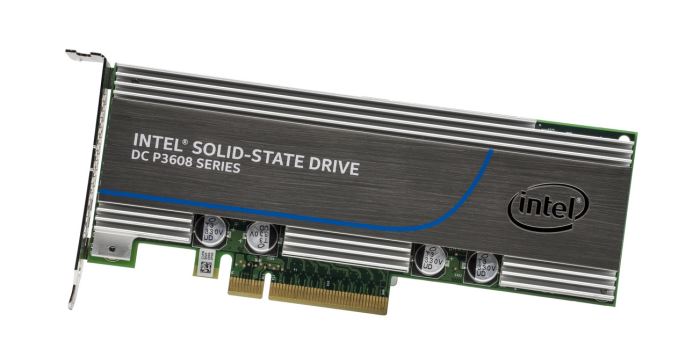Intel Announces SSD DC P3608 Series
by Billy Tallis on September 23, 2015 12:00 PM EST- Posted in
- Intel
- Storage
- SSDs
- PCIe SSD
- Enterprise SSDs

Intel is introducing a new family of enterprise PCIe SSDs with the aim of outperforming their existing DC P3600 series and even beating the DC P3700 series in many metrics. To do this, they've essentially put two P3600 SSDs on to one expansion card and widened the interface to 8 lanes of PCIe 3.0. While this does come across as a bit of a quick and dirty solution, it is a very straightforward way for Intel to deliver higher performance, albeit at the cost of sharply increased power consumption.
The SSD DC P3608 appears to the system as two individual NVMe drives behind a PLX PCIe switch chip. This means that extracting full performance from this card will require software RAID-0 or some similar software load-balancing solution. A new version of Intel's Rapid Storage Toolkit for Enterprise (RSTe) drivers will be providing this capability. The overhead of the PCIe switch and managing two independent controllers means that the P3608 cannot attain an oughtright doubling of the P3600's performance.
The inclusion of two SSD controllers and a PCIe switch chip also drives idle power consumption up to 11.5W and makes a 2.5" form factor impossible, so the P3608 series will only be available as a half-height half-length PCIe expansion card. Intel's not too worried about the form factor constraint, because they're now able to make full use of the 8-lane PCIe slots that are the most common in the sort of servers these drives are typically used in.
The SSD DC P3608 is available in three capacities, with the smallest 1.6TB configuration having more overprovisioning to boost random write speeds. Active power consumption varies with capacity, but all models support a power governor setting to limit power consumption to 35W or 25W instead of the worst-case 40W. Intel has provided us with a 1.6TB SSD DC P3608, so a full review is on its way.
| Intel Enterprise PCIe SSDs | |||||
| P3608 4TB | P3608 3.2TB | P3608 1.6TB | P3700 1.6TB | P3600 1.6TB | |
| Capacity | 4TB | 3.2TB | 1.6TB | 1.6TB | 1.6TB |
| 4kB Random Read (IOPS) | 850,000 | 850,000 | 850,000 | 450,000 | 450,000 |
| 4kB Random Write (IOPS) | 50,000 | 80,000 | 150,000 | 150,000 | 56,000 |
| Sequential Read (MB/s) | 5,000 | 4,500 | 5,000 | 2,800 | 2,600 |
| Sequential Write (MB/s) | 3,000 | 2,600 | 2,000 | 1,900 | 1,600 |
| Idle Power (W) | 11.5 | 11.5 | 11.5 | 4 | 4 |
| Read Power (W) | 20 | 18 | 18 | 10 | 9 |
| Write Power (W) | 40 | 35 | 30 | 22 | 20 |
| Form Factor | PCIe 3.0 x8 HHHL | PCIe 3.0 x4 HHHL or 2.5" 15mm | |||
| Endurance Rating | 3 DWPD | 15 DWPD | 3 DWPD | ||
| Warranty | 5 years | ||||
Source: Intel










27 Comments
View All Comments
Kjella - Wednesday, September 23, 2015 - link
At 100MB/s sequentially, so you get 30x the performance on the 4TB model for 4x the power. Not to mention if you have random writes, in IOPS/watt this is vastly superior. The only place HDDs win is in pure bulk capacity but for a TB-size database that's not what matters at all.MrSpadge - Wednesday, September 23, 2015 - link
High peak power consumption for a very short amount of time, as Lolimaster already said. There's no free lunch here - those electrons have to be pushed into their places if you want to write to flash.ddriver - Thursday, September 24, 2015 - link
I am pretty sure spinning a hard drive uses more power than pushing electrons. The high power usage is most likely because of the extra processing taking place in the SSD.wbwb - Wednesday, September 23, 2015 - link
Time is a factor in power consumption. If the SSD uses 40 watts and finishes the job in 0.5 second, while the spinner needs only 10 watts but takes 4 seconds to do the job, then surprise surprise, the spinner is using twice as much power.baconforall - Wednesday, September 23, 2015 - link
Good point, but it's important to distinguish between power (watts) vs energy (joules). FTFY:"Time is a factor in energy consumption..."
"... the spinner is using twice as much energy."
willis936 - Wednesday, September 23, 2015 - link
energy*ddriver - Thursday, September 24, 2015 - link
Do'h, the SSD consumes more power idling than the spinner while working :) If your system storage IO is loaded 100% of the time it is a good thing, but if the storage IO is idling, the SSD will inevitably use more power.Kristian Vättö - Thursday, September 24, 2015 - link
It's an enterprise drive, and a high-end one, so there will be practically no idle time. That's why manufacturers don't employ any idle power states like client drives do.DanNeely - Thursday, September 24, 2015 - link
Highspeed SSDs are used for IOPs limited situations not bulk storage; one SSD can service more random IO requests than a storage chassis stuffed with dozens of disks storing dozens of copies of the same data.SeanJ76 - Friday, September 25, 2015 - link
11 watts is too much? Lmao!!